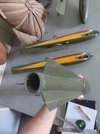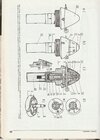Thanks for your replies, but my question was only about the lower bomb model in the photos, not about the sectioned ones. There are a total of 5 such bombs on display in the aviation hall at the National Military Museum in Bucharest. They are:
1. One sectioned bomb with incomplete fuze
2. One sectioned bomb with a complete fuze
3. One sectioned bomb with a complete fuze and no HE dummy filling
4. One unsectioned bomb with no nose fuze and weird tail section
5. Same as 4.
All the three first bombs have german PuW fuzes. Bomb 3 is clearly the night fragmetation bomb, whereas bombs 1 and 2 have the stepped inner profile but lack the illumination charge (they are probably missing and the painting of the section cut is not correct). Bombs 1 and 3 have holes in the fins for the polish-style vertical suspension eyelet, bomb 2 has the classic tail.
Bombs 5 and 4 have almost the same length as the PuW bombs (745mm, missing 5mm), no fuze and a completely different tail, made from three relatively complex sheet metal stampings. They form three straight fins and have a central tubular well that has two holes for a suspension eyelet (unknown exactly for what purpose, since the Barbieri launcher holds them horizontally with a wire). With this construction I would say it`s clear that these are dummy training bombs, but my question was mostly about their origin, because i think they are Romanian. I was hoping you can confirm or infirm this, based on your observations of other nation`s usage of these bombs (especially Poland).
Regarding your other comments, i don`t think there are Polish bombs without swept tails, because the fuze has a centrifugal safety system and without the bomb spinning, the fuze cannot work. Or maybe the Poles removed the centrifugal blocks from their model of fuze? I`m not sure, but i highly doubt it.
1. One sectioned bomb with incomplete fuze
2. One sectioned bomb with a complete fuze
3. One sectioned bomb with a complete fuze and no HE dummy filling
4. One unsectioned bomb with no nose fuze and weird tail section
5. Same as 4.
All the three first bombs have german PuW fuzes. Bomb 3 is clearly the night fragmetation bomb, whereas bombs 1 and 2 have the stepped inner profile but lack the illumination charge (they are probably missing and the painting of the section cut is not correct). Bombs 1 and 3 have holes in the fins for the polish-style vertical suspension eyelet, bomb 2 has the classic tail.
Bombs 5 and 4 have almost the same length as the PuW bombs (745mm, missing 5mm), no fuze and a completely different tail, made from three relatively complex sheet metal stampings. They form three straight fins and have a central tubular well that has two holes for a suspension eyelet (unknown exactly for what purpose, since the Barbieri launcher holds them horizontally with a wire). With this construction I would say it`s clear that these are dummy training bombs, but my question was mostly about their origin, because i think they are Romanian. I was hoping you can confirm or infirm this, based on your observations of other nation`s usage of these bombs (especially Poland).
Regarding your other comments, i don`t think there are Polish bombs without swept tails, because the fuze has a centrifugal safety system and without the bomb spinning, the fuze cannot work. Or maybe the Poles removed the centrifugal blocks from their model of fuze? I`m not sure, but i highly doubt it.
Attachments
Last edited:



